A Critical Assessment and Projection of Urban Vertical Growth in Antofagasta, Chile
Abstract
:1. Introduction
2. Case Study
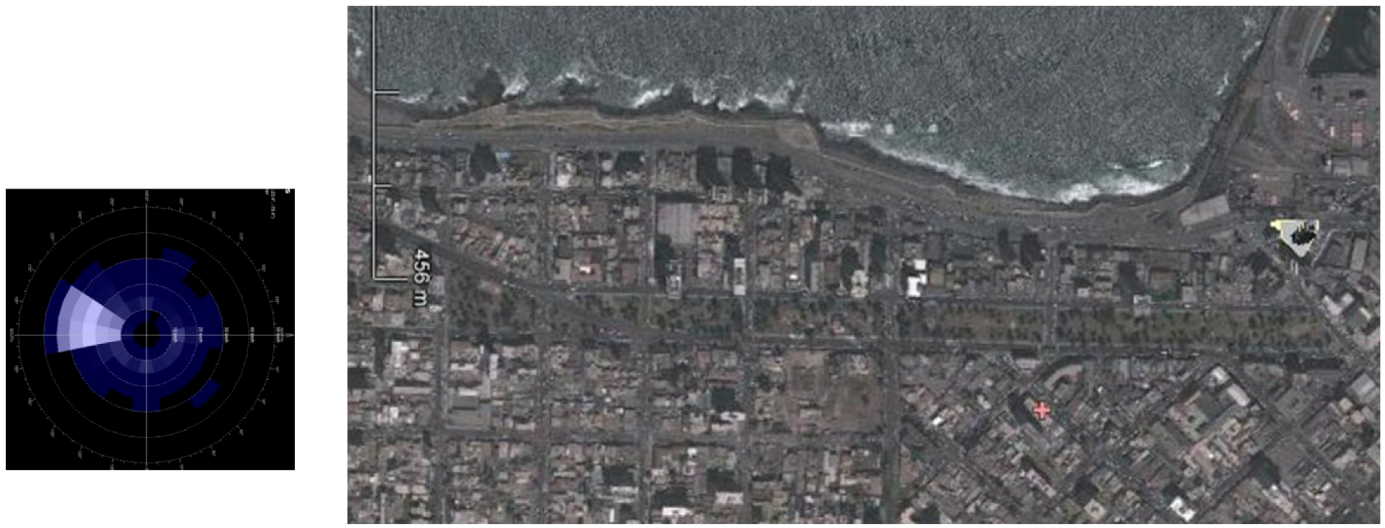
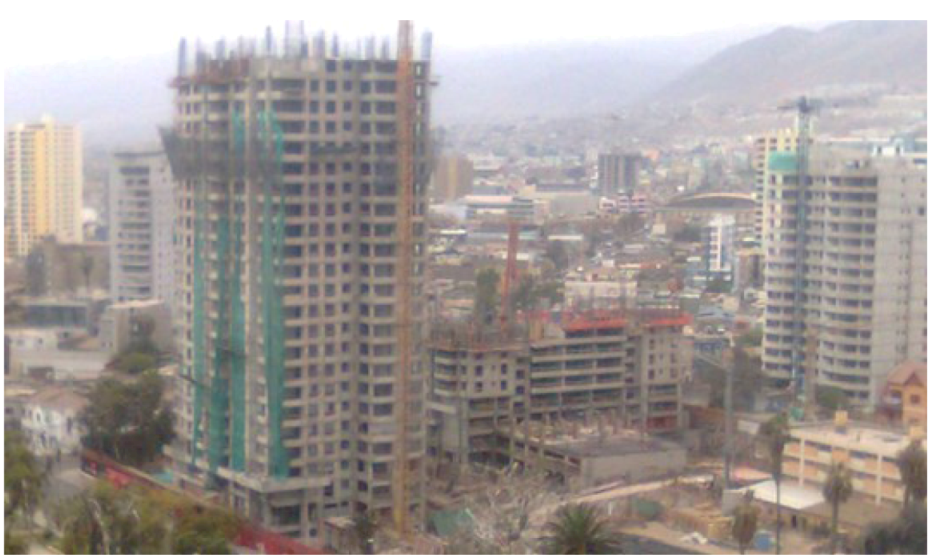
3. Methodology
3.1. Architecture Workshop
- -
- Urban light, acoustic and climatic environment;
- -
- Building needs in terms of operability, services, public and private zones;
- -
- Integration of energy and comfort concepts.
3.2. Defining “Urban Sustainability”
- to consider 30% of soil use as green area;
- to permit a maximum of 6 floors (maximum high without elevators) of residential blocks;
- to plan the orientation of blocks to use better the wind (heat evacuation);
- to stop patrimonial houses demolition.
3.3. Simulation Studies and Experiment
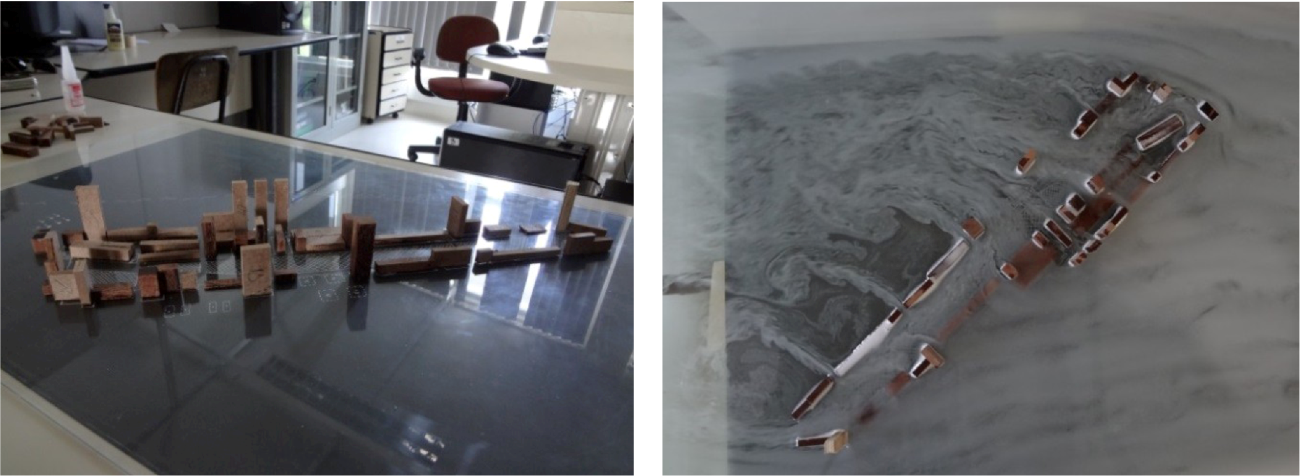
4. Results and Discussion
- -
- Shadows and solar exposition;
- -
- Temperature and humidity;
- -
- Wind protection and natural ventilation.
4.1. Shadows and Solar Exposition

4.2. Temperature and Humidity
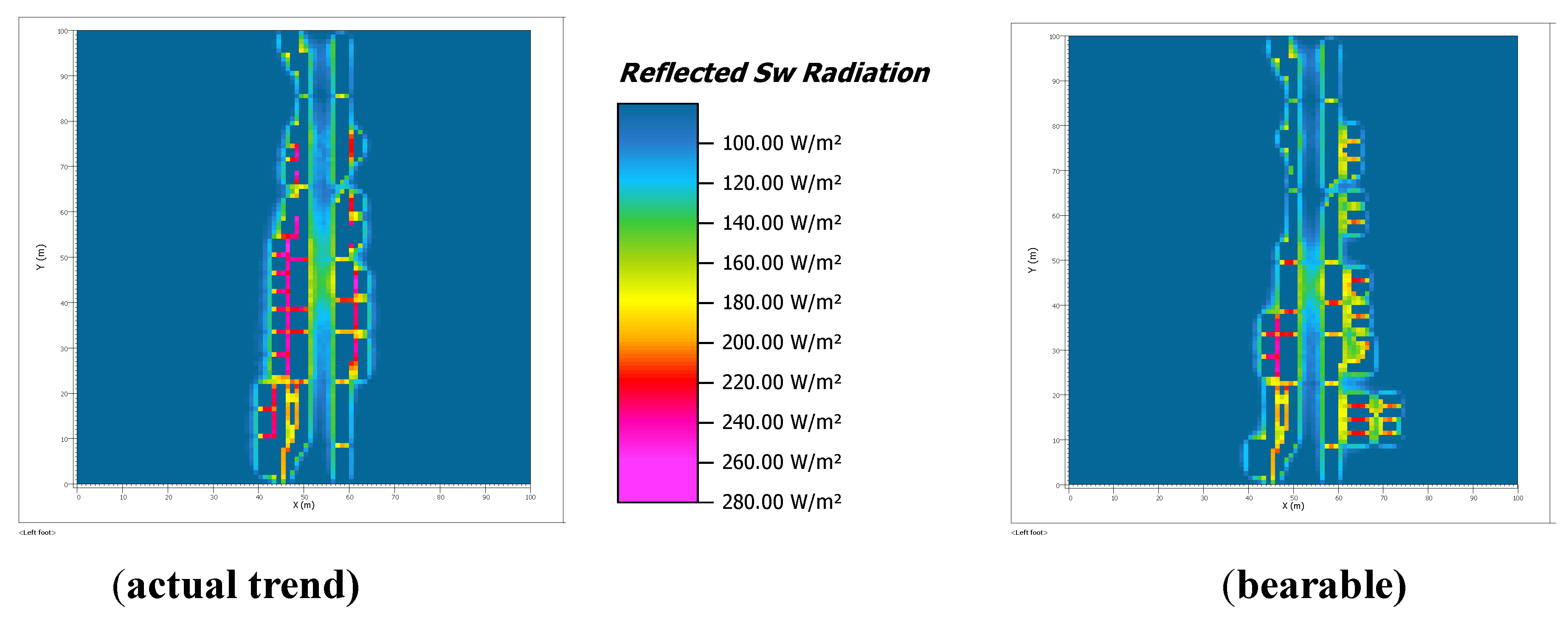
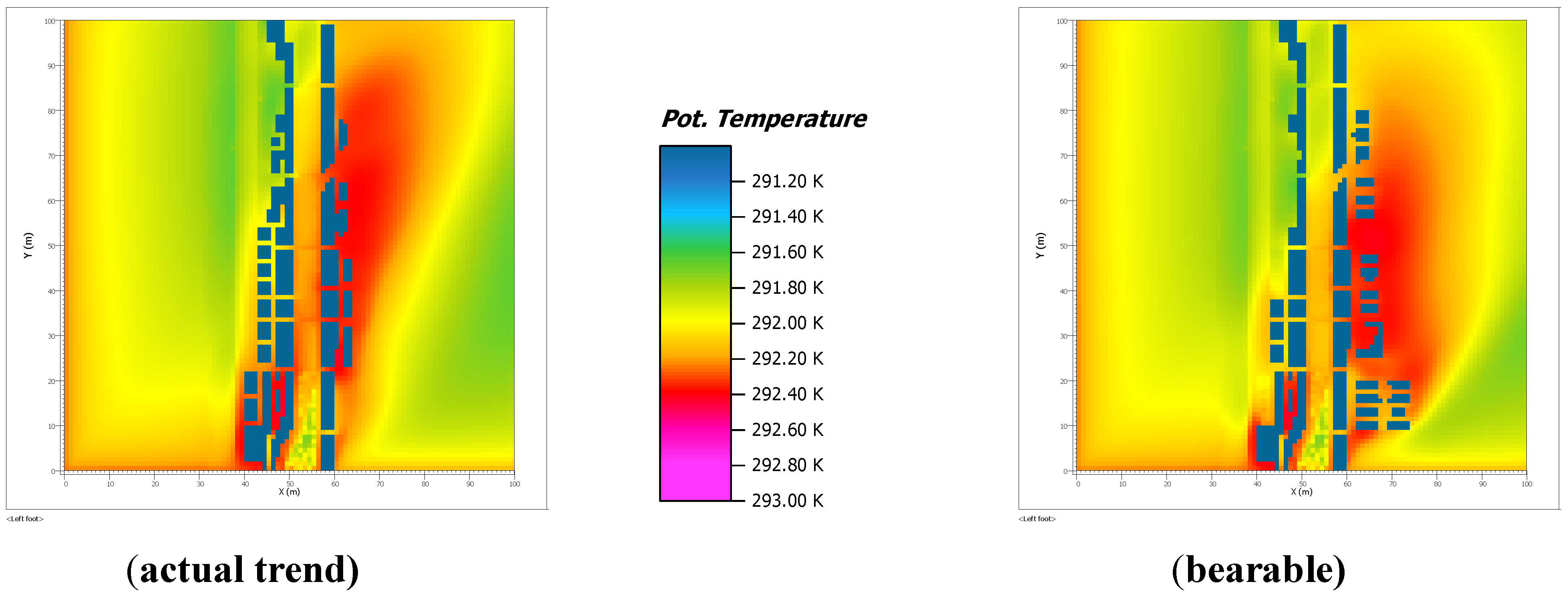
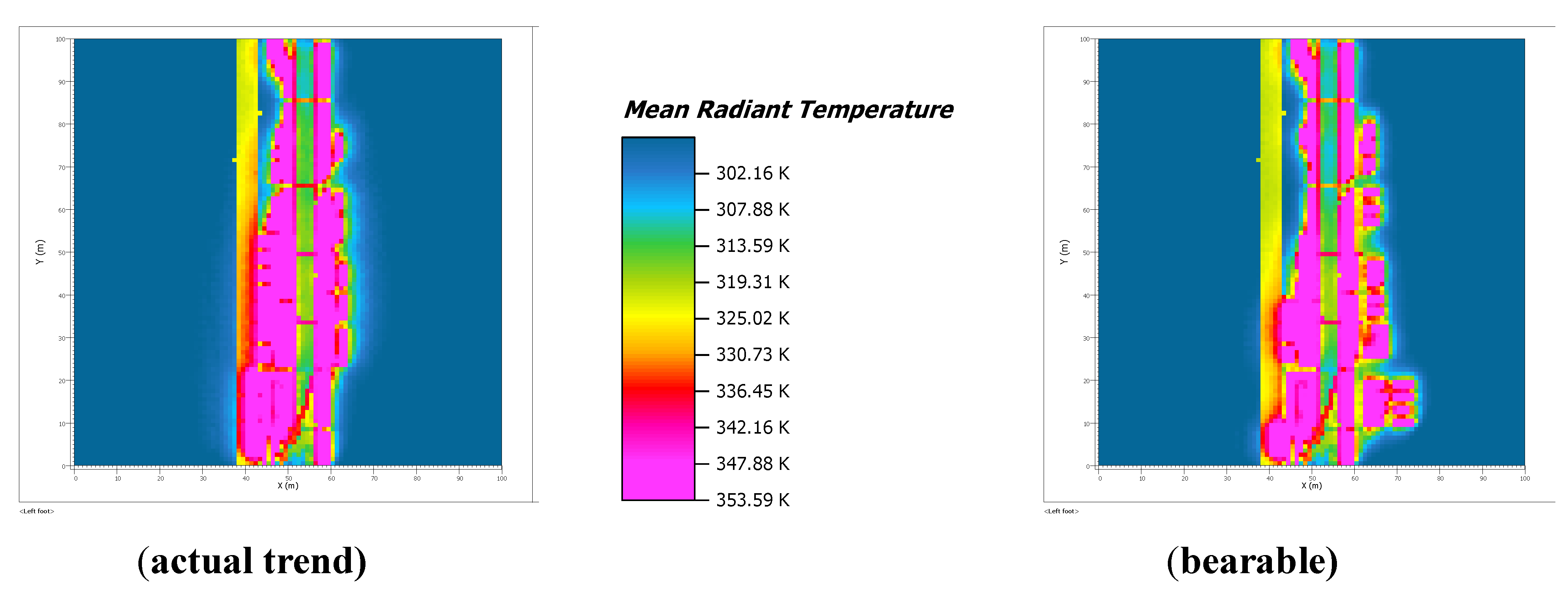
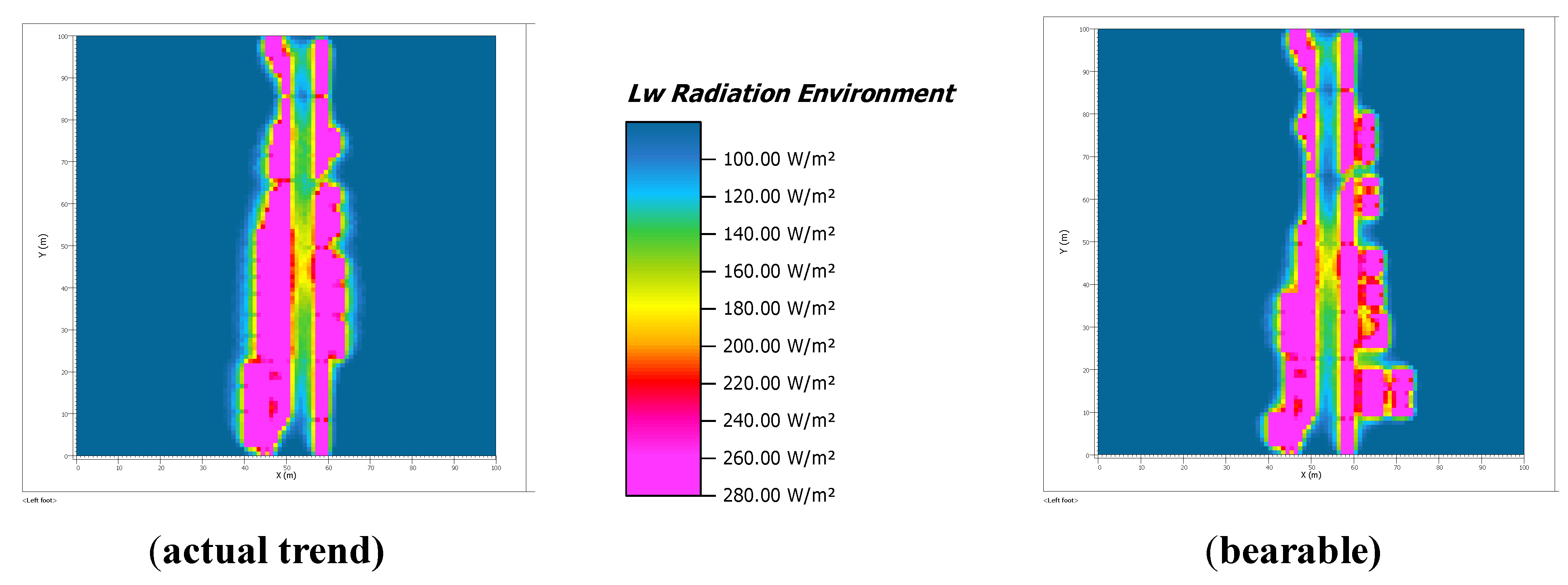
4.3. Air Flows

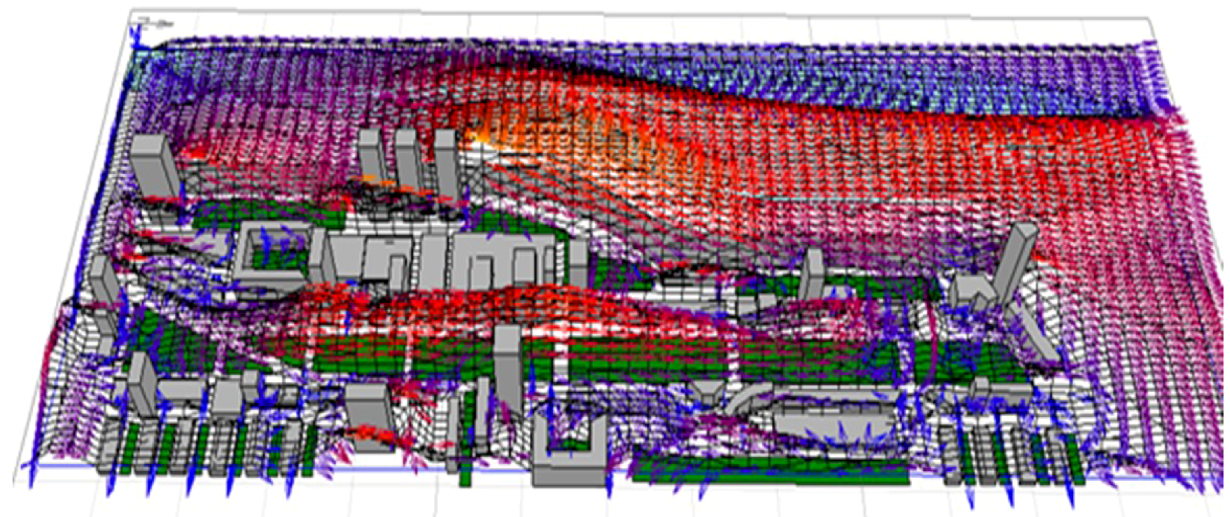
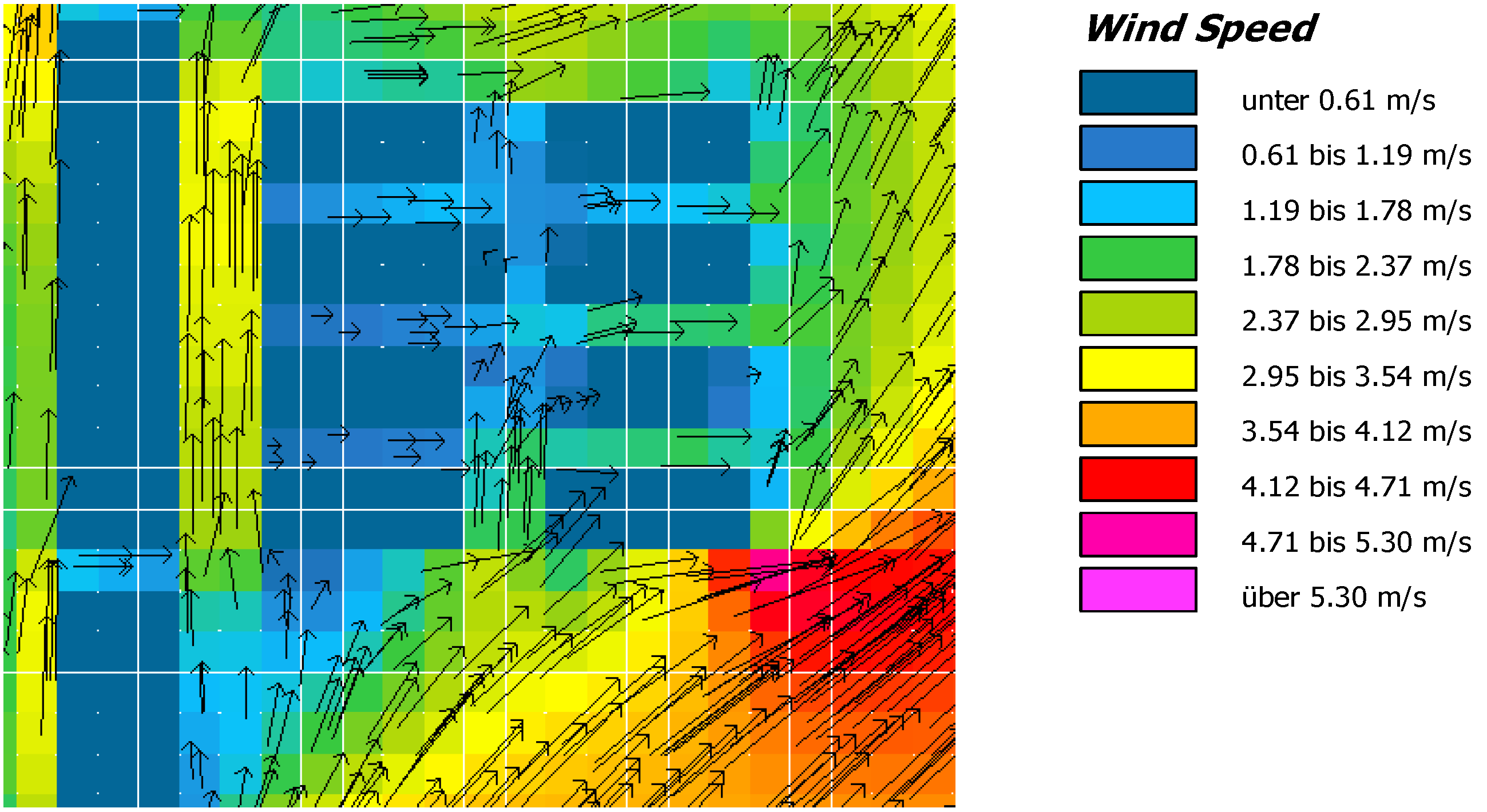
| H | Met | Clo | T (°C) | RH (%) | V (m/s) | MRT (°C) | PMV | PPD | ||||||
|---|---|---|---|---|---|---|---|---|---|---|---|---|---|---|
| A | B | A | B | A | B | A | B | A | B | A | B | |||
| 8 | 1.5 | 1.5 | 13.9 | 14.0 | 60 | 60 | 2.2 | 2.1 | 10.9 | 10.7 | −0.8 | −0.8 | 18.5 | 18.5 |
| 9 | 1.5 | 1.5 | 19.3 | 19.1 | 53 | 54 | 1.3 | 1.4 | 18.0 | 17.0 | 0.2 | 0.1 | 5.8 | 5.2 |
| 10 | 1.5 | 1.5 | 19.9 | 19.8 | 51 | 52 | 1.5 | 1.6 | 19.9 | 19.9 | 0.3 | 0.2 | 6.9 | 5.8 |
| 11 | 1.5 | 1.5 | 21.0 | 20.9 | 47 | 48 | 1.3 | 1.3 | 27 | 26.8 | 0.7 | 0.6 | 15.3 | 12.5 |
| 12 | 1 | 1 | 22.4 | 22.2 | 44 | 45 | 1.3 | 1.4 | 52.1 | 51.0 | 1.4 | 1.2 | 45.5 | 35.2 |
| 13 | 1 | 1 | 23.6 | 23.5 | 41 | 42 | 1.4 | 1.4 | 47.3 | 46.5 | 1.1 | 1 | 30.5 | 26.1 |
| 14 | 1 | 1 | 24.6 | 24.6 | 38 | 39 | 1.5 | 1.6 | 45.0 | 45.0 | 1.2 | 1.1 | 35.2 | 30.1 |
| 15 | 1 | 1 | 25.2 | 25.0 | 33 | 31 | 1.5 | 1.5 | 34.0 | 32.5 | 0.4 | 0.2 | 8.3 | 5.8 |
| 16 | 1.5 | 1.5 | 19.4 | 19.2 | 49 | 47 | 1.3 | 1.4 | 10.3 | 9.8 | −0.1 | −0.1 | 5.2 | 5.2 |
| 17 | 1.5 | 1.5 | 19.3 | 19.1 | 53 | 53 | 1.2 | 1.2 | 9.7 | 9.6 | −0.1 | −0.1 | 5.2 | 5.2 |
| 18 | 1.5 | 1.5 | 19.2 | 19.0 | 53 | 54 | 1.2 | 1.3 | 9.5 | 9.2 | −0.1 | −0.1 | 5.2 | 5.2 |
4.4. Design Workshop “Energy and Architecture” Results
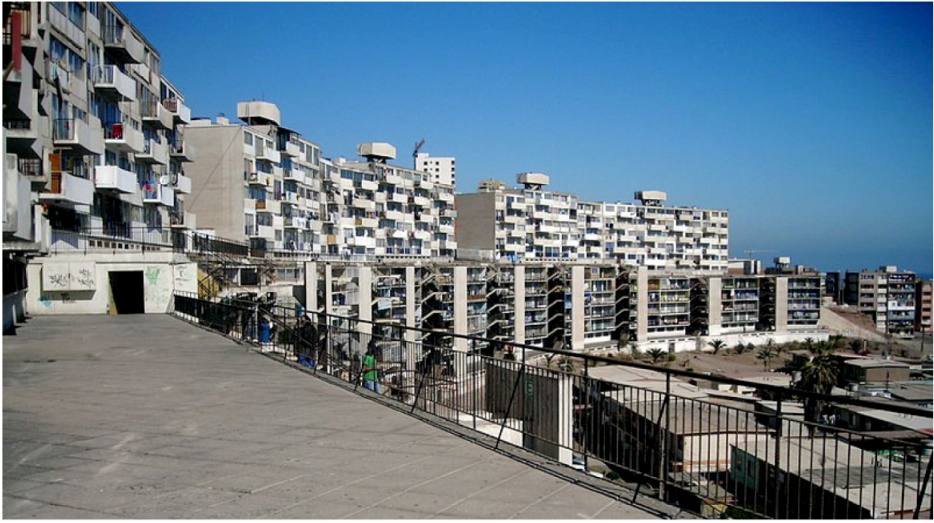


5. Discussion and Future Work
6. Conclusions
Conflict of Interest
Acknowledgements
References
- Newman, P.; Beatley, T.; Boyer, H. Resilient Cities:Responding to Peak Oil and Climate Change; Island Press: Washington, DC, USA, 2009. [Google Scholar]
- Bo-ot, L.M.; Wang, Y.H.; Chiang, C.M.; Lai, C.M. Effects of a green space layout on the outdoor thermal environment at the neighborhood level. Energies 2012, 5, 3723–3735. [Google Scholar] [CrossRef]
- Isalgué, A.; Coch, H.; Serra, R. Scaling laws and the modern city. Phys. A: Stat. Mech. Appl. 2007, 382, 643–649. [Google Scholar] [CrossRef]
- Wächter, P. The Impacts of Spatial Planning on Degrowth. Sustainability 2013, 5, 1067–1079. [Google Scholar] [CrossRef]
- Ghanghermeh, A.; Roshan, G.; Orosa, J.; Calvo-Rolle, J.; Costa, A. New Climatic Indicators for Improving Urban Sprowl: A Case Study of Tehran City. Entropy 2013, 15, 999–1013. [Google Scholar] [CrossRef]
- Bettencourt, L.; West, G. The laws of the city. The Eonomist. 23 June 2012. Available online: http://www.economist.com/node/21557313 (accessed on 19 June 2013).
- Coch, H.; Isalgué, A.; Serra, R. Leyes de Escala en Los EspaciosUrbanos. In Proceedings of 5th International Conference Virtual City and Territory, Barcelona, Spain, 2–4 June 2009; Centre de Política de Sòl i Valoracions: Barcelona, Spain, 2009; pp. 385–392. [Google Scholar]
- Bettencourt, L.; West, G. A unified theory of urban living. Nature 2010, 467, 912. [Google Scholar] [CrossRef]
- Wheeler, S. Planning for Sustainability: Creating Livable, Equitable, and Ecological Communities; Routledge: New York, NY, USA, 2004. [Google Scholar]
- Robinson, D. Computer Modelling for Sustainable Urban Design; Earthscan Ltd.: London, UK, 2011. [Google Scholar]
- Hatuka, T.; Saaroni, H. Resilience of outdoor spaces in an era of climate change: The problem of developing countries. Sustainability 2013, 5, 90–99. [Google Scholar] [CrossRef]
- Zuleta, R. Física del Ambiente (in Spanish); UCN Publisher: Antofagasta, Chile, 2009. [Google Scholar]
- Autodesk Ecotect Analysis. Available online: http://usa.autodesk.com/ecotect-analysis/ (accessed on 19 June 2013).
- Eas Envimet. Available online: http://www.envimet.com (accessed on 19 June 2013).
- World Commission on Environment and Development (WCED), Our Common Future; Oxford University Press: New York, NY, USA, 1987.
- CREO introduction and work plan (in Spanish). Available online: http://www.creoantofagasta.cl (accessed on 16 April 2013).
- Yahia, M.W. Microclimate and thermal comfort of urban spaces in hot dry Damascus, influence of urban design and planning regulations. Ph.D. Thesis, Housing Development & Management, Lund University, Lund, Sweden, 2007. [Google Scholar]
- Bruse, M. Simulating Microscale Climate Interactions in Complex Terrain with a High-resolution Numerical Model: A Case Study for the Sydney CBD Area. In Proceedings of International Conference on Urban Climatology & International Congress of Biometeorology, Sydney, Australia, 8–12 November 1999.
- Han, S.G.; Mun, S.H.; Huh, J.H. Changes of the Micro Climate and Building Cooling Load due to the Green Effect of a Restored Stream in Seul, Korea. In Proceedings of Building Simulation, Bejijng, China, 3–7 September 2007.
- Nicolopoulou, M.; Baker, N.; Steemers, K. Thermal comfort in outdoor urban spaces: Understanding the human parameter. Sol. Energy 2001, 70, 227–235. [Google Scholar] [CrossRef]
- Nicolopoulou, M.; Steemers, K. Thermal comfort and psychological adaptation as a guide for designing urban spaces. Energy Build. 2003, 35, 95–101. [Google Scholar] [CrossRef]
- Rogora, A.; Dessí, V. Il Comfort Ambientale Negli Spazi Aperti (in Italian); Edicom Publisher: Monfalcone, Italy, 2005. [Google Scholar]
- Palme, M.; Ordenes, M. Análisis de las condiciones de ventilación dentro del contexto urbano para la Avenida Brasil en Antofagasta (in Spanish). Encontro Latinoamericano Do Confort no Ambiente Construido 2013, in press. [Google Scholar]
- Palme, M. Simulation of Vertical Growth Near the Green Area of “Avenida Brasil” in Antofagasta Midtown, Chile. Available online: http://www.sciforum.net/presentation/943 (accessed on 19 June 2013).
- Palme, M.; Guerra, J. Urban simulation and environmental evaluation of vertical growth in Antofagasta midtown. In Proceedings of Building Simulation Conference, Chambéry, France, 25–28 August, 2013. in press.
- Galeno, C. Antofagasta, Chile. Modern architecture between ocean and desert. Docomomo J. 2007, 37, 24–29. [Google Scholar]
- Galeno, C. Ricardo Pulgar San Martín. El conjunto habitacional Gran Vía y el edificio Huanchaca. In Proceedings of Docomomo: trayectorias de la ciudad moderna, IV Seminario Nacional Docomomo Chile (in Spanish), Concepción, Chile, 21–24 November 2012.
- Pagés, A.; Palme, M.; Isalgué, A.; Coch, H. Energy Consumption and CO2 of Flats in the Construction and use According to Floor Area. In Proceedings of the World Renewable Energy Congress 2008, Glasgow, UK, 19–25 July 2008.
- Pérez, R. Domicilio Urbano (in Spanish); ARQ Publisher: Santiago, Chile, 2012. [Google Scholar]
- Palme, M.; Isalgué, A.; Coch, H. Avoiding the possible impact of climate change on the built environment: The importance of the building’s energy robustness. Buildings 2013, 3, 191–204. [Google Scholar] [CrossRef] [Green Version]
- Palme, M.; Isalgué, A.; Coch, H.; Serra, R. Robust Design: A Way to Control Energy use from Human Behavior in Architectural Spaces. In Passive and Low Energy Architecture, Proceedings of PLEA 2006 Conference, Géneve, Switzerland, 6–8 September 2006.
- Palme, M.; Isalgué, A.; Coch, H.; Serra, R. Energy Consumption and Robustness of Buildings. In Central Europe towards Sustainable Buildings, Proceedings of CESB 10 Conference, Prague, Czech Republic, 30 June–2 July 2010.
- López, A.; Azevedo, J.; Rodriguez, I.; Rey, D.; Gándara, D.; Montes, E.; Peralta, J.; Sosa, I.; Guerra, J.; Aguacil, M. Ecoaldeas or Self-Sustainable Communities and Renewable Energy Solutions. Renew. Energy Power Qual. J. 2012, 10, 487–494. [Google Scholar]
- Olgyay, V. Design with Climate; Princeton University Press: Princeton, NJ, USA, 1963. [Google Scholar]
© 2013 by the authors; licensee MDPI, Basel, Switzerland. This article is an open access article distributed under the terms and conditions of the Creative Commons Attribution license (http://creativecommons.org/licenses/by/3.0/).
Share and Cite
Palme, M.; Ramírez, J.G. A Critical Assessment and Projection of Urban Vertical Growth in Antofagasta, Chile. Sustainability 2013, 5, 2840-2855. https://doi.org/10.3390/su5072840
Palme M, Ramírez JG. A Critical Assessment and Projection of Urban Vertical Growth in Antofagasta, Chile. Sustainability. 2013; 5(7):2840-2855. https://doi.org/10.3390/su5072840
Chicago/Turabian StylePalme, Massimo, and José Guerra Ramírez. 2013. "A Critical Assessment and Projection of Urban Vertical Growth in Antofagasta, Chile" Sustainability 5, no. 7: 2840-2855. https://doi.org/10.3390/su5072840




